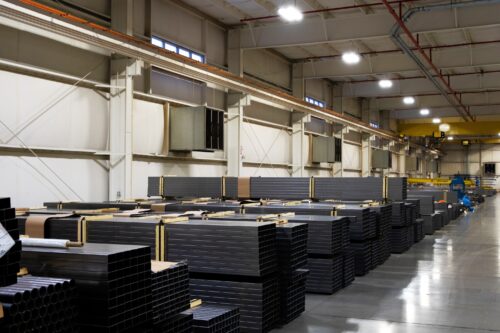
When it comes to creating durable and safe products, understanding the strength of the metals used is critical. In industries where precision and longevity are key, choosing the right material can be the difference between success and failure.
At BUILT Systems, we know that delivering reliable manufacturing solutions starts with using the best materials. That’s why we’ve chosen cold rolled steel as the foundation for our ergonomic products. It’s got the strength and the smooth finish to handle the toughest industrial environments and still impress visually.
In this blog, we’ll explore the factors that influence metal strength and discuss the testing methods. Whether you’re looking for long-lasting solutions or just curious about what makes cold rolled steel stand out, this guide will help you understand the science behind strong manufacturing.
Key Factors Influencing Cold Rolled Steel Strength
- Cold Working Cold rolled steel is produced by passing the metal through rollers at temperatures below its recrystallization point. This process increases the steel’s strength through work hardening, as the metal’s crystal structure becomes more compact and dislocations are introduced. The result is a material that is not only stronger but also has a smoother surface finish, which is crucial for the precise, clean appearance of BUILT Systems’ products.
- Grain Structure The cold rolling process refines the grain structure of the steel, producing smaller, more uniform grains. This refinement enhances the steel’s strength and toughness, making it more resistant to deformation and wear. For BUILT Systems, this means our products can withstand the demands of daily use in industrial environments without compromising on performance.
- Surface Finish One of the key benefits of cold rolled steel is its superior surface finish. The smoother, more uniform surface not only enhances the aesthetic appeal of our products but also contributes to their strength by reducing surface imperfections that could act as stress concentrators.
- Environmental Factors Like all metals, cold rolled steel can be affected by environmental conditions, particularly corrosion. However, the tighter grain structure and smoother surface of cold rolled steel offer better resistance to oxidation. Additionally, at BUILT Systems, we apply powder coat finishes to further enhance the steel’s durability, ensuring that our products maintain their strength and appearance over time.
Methods for Testing Metal Strength
All metals, including cold-rolled steel, undergo a series of strength tests to assess their performance across a range of critical factors. These tests help determine how they measure up in key areas like durability, hardness, and resistance, ensuring that they meet the standards required for various applications.
- Tensile Testing Tensile testing measures a metal’s ability to withstand tension (being pulled apart). A sample is stretched until it breaks, and the maximum stress it can endure is recorded as its tensile strength. This method is particularly useful in determining how much load a metal can handle before failing.
- Hardness Testing Hardness tests, such as the Brinell, Rockwell, and Vickers methods, involve pressing a hard indenter into the metal surface and measuring the depth or size of the indentation. The harder the metal, the smaller the indentation, indicating greater strength. These tests are quick and provide valuable insights into a metal’s resistance to deformation.
- Impact Testing Impact tests, like the Charpy or Izod test, evaluate a metal’s toughness—its ability to absorb energy before fracturing. A sample is struck with a pendulum hammer, and the energy absorbed in the process is measured. This is especially important for metals used in structures or components exposed to sudden loads or impacts.
- Fatigue Testing Fatigue testing assesses how a metal performs under repeated loading and unloading cycles. It’s crucial for components subjected to constant stress, such as those in material handling systems or workstations. By understanding the fatigue limits of metals, we ensure that our products maintain their strength and reliability over time.
- Compression Testing While tensile testing measures how well a metal can resist being pulled apart, compression testing measures its ability to withstand being pushed together. This test is vital for components that will bear heavy loads, ensuring they don’t deform or fail under pressure.
At BUILT Systems, we believe that understanding the strength of the materials we work with is foundational to delivering the high-quality, durable products our clients expect. Whether you’re looking for robust workstations, reliable material handling solutions, or various ergonomic manufacturing products, our commitment to quality begins with understanding and optimizing the strength of the materials we use.
